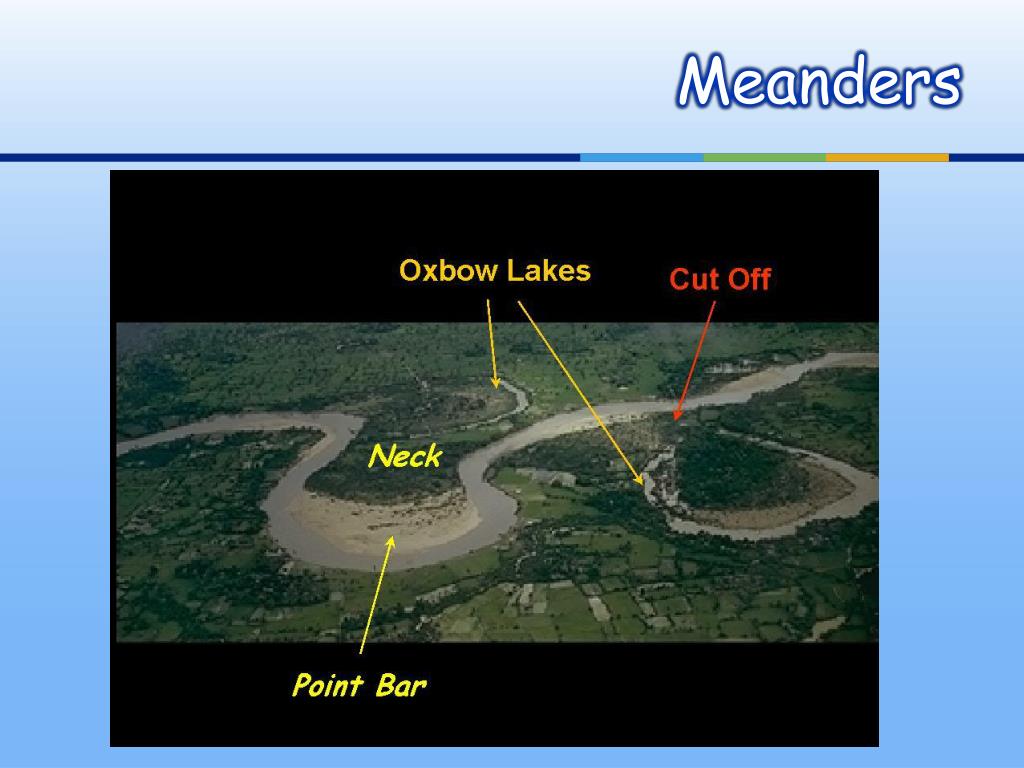

This map shows the elevations of Priest Creek in the Kelowna area. Gradient is the key factor controlling stream velocity, and of course, velocity controls sediment erosion and deposition. Numerous oxbow lakes are present and another meander cutoff will soon take place. Figure 13.22 The meandering channel of the Nowitna River, Alaska. When this happens, another oxbow lake will form like the others in the photo. The meander in the middle of the photo has reached the point where the thin neck of land between two parts of the channel is about to be eroded through. Ī well-developed meandering river is shown in Figure 13.22. The sand and gravel point bar must have formed when the creek was higher and the flow faster than it was when the photo was taken. Figure 13.21 The meandering channel of the Bonnell Creek, Nanoose, B.C. Over time, the sinuosity of the stream becomes increasingly exaggerated, and the channel migrates around within its flood plain, forming a meandering pattern.

This leads to erosion of the banks on the outside of the curve, deposition on the inside, and formation of a point bar (Figure 13.21). As you saw in Figure 13.14, when a stream flows around a corner, the water on the outside has farther to go and tends to flow faster. Ī stream that occupies a wide, flat flood plain with a low gradient typically carries only sand-sized and finer sediments and develops a sinuous flow pattern. Figure 13.20 The braided Coldwater River, Mt. Helens in Washington State is a good example of this (Figure 13.20). One such environment is in volcanic regions, where explosive eruptions produce large amounts of unconsolidated material that gets washed into streams.

īraided streams can develop anywhere there is more sediment than a stream is able to transport. Figure 13.19 The braided channel of the Kicking Horse River at Field, B.C.
EARTH SCIENCE MEANDER DEFINITION SERIES
The youthful streams have high sediment loads, and when they flow into the lower-gradient glacial valleys where the velocity isn’t high enough to carry all of the sediment, braided patterns develop, characterized by a series of narrow channels separated by gravel bars (Figure 13.19). In mountainous terrain, such as that in western Alberta and B.C., steep youthful streams typically flow into wide and relatively low-gradient U-shaped glaciated valleys. This stream has a step-pool morphology and a deep bedrock channel. Figure 13.18 The Cascade Falls area of the Kettle River, near Christina Lake, B.C. They also have steep gradients and steep and narrow V-shaped valleys - in some cases steep enough to be called canyons. As shown in Figures 13.1 and 13.18, youthful streams commonly have a step-pool morphology, meaning that the stream consists of a series of pools connected by rapids and waterfalls. Youthful streams that are actively down-cutting their channels tend to be relatively straight and are typically ungraded (meaning that rapids and falls are common). The cycle of erosion has some influence on the nature of a stream, but there are several other factors that are important. Stream channels can be straight or curved, deep and slow, or rapid and choked with coarse sediments.


 0 kommentar(er)
0 kommentar(er)
